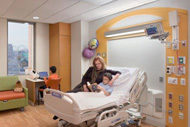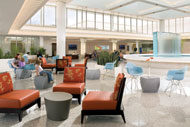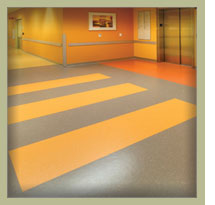 Health care facilities are busy, with staff and patients driving activities and processes around the clock. Each day presents a different set of challenges.
Health care facilities are busy, with staff and patients driving activities and processes around the clock. Each day presents a different set of challenges.
Building materials within a health care facility impact the efficiency and effectiveness of the operations staff, the well-being of patients and employees, the indoor health of the space and the bottom line of the facility.
The following case studies explore how some health care facilities addressed these challenges through their flooring selection.
Case 1: Child-friendly ED flooring
Treating nearly 70,000 patients each year, the Children's Medical Center, Dayton, Ohio, operates a very busy emergency department (ED). Before the department underwent a series of renovations and additions, Cindy Burger, the medical center's director of critical care, emergency and trauma services, identified three main criteria that materials used in the expansion needed to meet.
Flooring, for example, needed to provide enhanced acoustic qualities, low-maintenance requirements and great ergonomic benefits for busy staff members. Because the ED is such a busy area, providing a quiet, comfortable atmosphere for patients and families while implementing a maintenance regimen that avoids interruptions was a major goal of the center.
Following a three-month test installation, Burger chose a high-performance rubber floor covering for multiple areas of the facility, including trauma rooms, patient rooms, corridors, the radiology room and the casting room. "We needed a material that would meet the challenges of a busy ED," explains Burger. "By installing a rubber floor, we were able to accomplish our goals – both from a design and performance perspective."
The design of the facility – most notably the color scheme – served as an important factor in meeting the comfort needs of visiting patients and families. "Nobody likes visiting an ED or trauma room, especially children, so we take pride in making children and their families comfortable," adds Burger. "We were able to achieve a color scheme within the flooring to help patients and their families stay comfortable and relaxed."
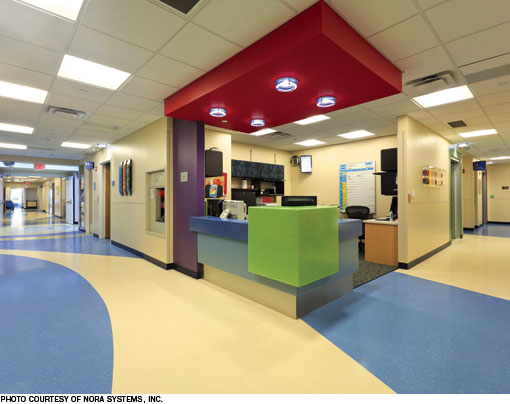 |
| Rubber flooring provides the acoustic benefits, low-maintenance and comfort underfoot that Children's Medical Center of Dayton requires for its busy ED. |
The center also worked to create a calm and quiet atmosphere that comforts visiting patients and families – a difficult task for any ED. "With the sounds of children around our high-stress environment, we need all the help we can get to keep the noise down," reiterates Burger. "Even though we are busier than before, it seems quieter now, and the flooring definitely helps contribute to that."
While patients and families have always been the hospital's main focus, officials also paid attention to the well-being and efficiency of the staff and the facility. Thanks to the installation of the rubber flooring, Dayton Children's is able to provide staff members and volunteers with the underfoot comfort so important in fighting the fatigue that comes from constantly work on their feet. The floor also offers an efficient maintenance regimen. The flooring's no-wax surface saves maintenance staff time on cleaning the floors while also offering scheduling flexibility. Staff can now perform maintenance without disrupting those working and receiving care in the ED.
Not only have staff members noticed a difference with the floors, but so have patients and visitors. "When I give a facility tour, I always receive compliments about the floors," says Burger, who stated that the hospital will consider using the flooring in other areas in the future. "At the end of the day, I want families and staff alike to be comfortable, and the flooring really helps accomplish that goal."
Case 2: Critical care standards
Updating a 90-year-old facility brings challenges from a design perspective, but it also presents a variety of performance challenges. Manchester (Conn.) Memorial Hospital, a 15,000-square-foot space that encapsulates 22 private patient rooms, nursing stations, supply rooms, corridors, waiting areas and consultation rooms, tasked architects, designers and hospital officials with overcoming both sets of challenges during a recent renovation.
"We took the critical care suites from open bays with curtains dividing beds and crowded nursing stations, to a state-of-the-art unit that promotes healing, incorporates new technology and features private patient rooms, more comfortable work stations and colorful finishes, including the floor," notes David Fanuele, project architect, Symmes Maini & McKee Associates Inc.
After much deliberation, Manchester Memorial Hospital selected sustainable rubber flooring to support the hospital's goal of a low-maintenance solution that saves time and money. The extended life cycle of the flooring – which is typically around 30 years for the type of rubber flooring they chose – provides the hospital with significant savings over the lifetime of the flooring.
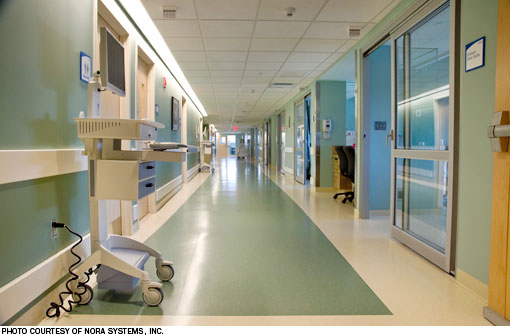 |
| The dense, nonporous surface of rubber flooring simplifies the maintenance process at Manchester Memorial Hospital and helps with infection control by preventing spills from seeping into the floor. |
According to James Odom, director of environmental and linen services at Manchester Memorial, the maintenance staff simply dust mops and runs an autoscrubber daily to maintain the flooring. "The floor dries immediately and is always shining. There's no stripping or waxing involved, so I don't have to schedule floor maintenance around patients and visitors. I estimate that it saves me $5,000 to $10,000 a year in maintenance costs, because we do not have to strip or burnish the floors or purchase additional maintenance products."
The dense surface not only allows the maintenance staff to efficiently clean the flooring, but also offers health benefits by preventing water and spills of other substances from leaking into the seams. "The flooring is nonporous, which means it helps with infection control. If anything spills on the floor, there's no place for it to go," Odom explains. "Instead of spills or micro-organisms seeping into the floor, they sit on top of the floor, where they can be easily and quickly mopped up."
Odom is so happy with the rubber flooring, he is recommending the hospital consider using it for any future renovation projects where foot traffic is heavy, ease of maintenance is important, durability is required and high-quality design is desired. "Because of what it saves us in maintenance costs, it's a product that pays for itself within a year or two."
Case 3: Commitment to total health
Kaiser Permanente is the nation's largest not-for-profit health plan, with 36 hospitals and more than 500 medical offices and other outpatient facilities. Vacaville (Calif.) Medical Center is a 340,000-square-foot, four-story hospital that provides 24-hour emergency services, adult inpatient medicine, private rooms, surgical services and advanced diagnostic imaging to communities in California's Napa-Solano region. Vacaville Medical Center's floor plan closely resembles that of other facilities constructed, owned and operated by the company. Area residents can also access the specialty services in the 219,000-square-foot, attached medical office building which include ambulatory surgery, cardiology, oncology and urology.
Planners at Vacaville Medical Center aimed to incorporate sustainable and functional building materials while demonstrating Kaiser Permanente's commitment to the total health of its members, community, employees and physicians.
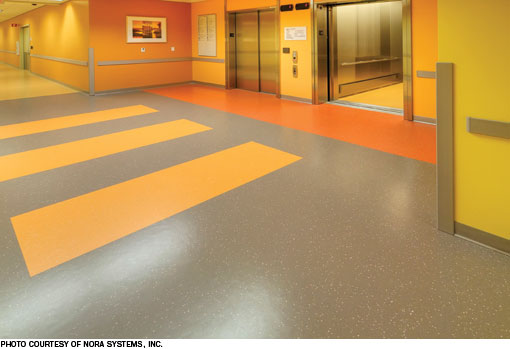 |
| Rubber flooring served as the starting point for a colorful, sustainable floor plan at Vacaville Medical Center. |
"Kaiser Permanente's new [design] templates introduce lots of color in the new construction and remodel of hospitals and medical office buildings," says Jeanine Wernecke, project manager, Kaiser Permanente. The result is a medical center featuring a sustainable design that incorporates more than 35 colors in floor coverings, paint colors and furnishings.
At the heart of this colorful, sustainable floor plan is the rubber floor covering, which served as the starting point in development of the overall design. "My rule of thumb is to choose the flooring first and build my palette around the colors and patterns the floor covering offers," explains J.J. Jang, associate, Stantec Architecture. "The more options and choices in a floor covering, the easier it is to match everything and work with a concept."
Jang specified low-maintenance rubber flooring throughout the medical center – in patient rooms, corridors, nursing stations, treatment areas and operating suites. "I even put it in the waiting rooms located off the corridors. These areas are typically carpeted," she notes. "But, I just love the way rubber worked in these areas, and now the cleaning crew no longer has to bring additional equipment into the corridors to clean carpeting."
Wernecke agrees, citing the improved indoor air quality (IAQ) it promotes throughout the facility. "The floors look great and at the same time, offer a number of performance benefits," she says. "The rubber flooring is free of PVC and does not leach toxins into the air. Nor does it need to be waxed or stripped with harsh chemicals. In addition, the rubber flooring offers better traction, is more stain resistant, improves facility acoustics and provides cushioning for nurses and staff."
According to Wernecke, the flooring contributes to the medical center's sustainable design and fits in with the goal to promote the total health of the center's members, community, employees and physicians.
"We design buildings for the future, with room to expand and with green materials that promote the health of patients and the environment," says Wernecke. "We like that the floor coverings from this manufacturer are made from natural rubber and raw materials and are created using eco-friendly manufacturing methods. For us, that's huge."
Performance benefits
Rubber flooring provides health care facilities with benefits that enhance patient experience and safety, as well as long-term performance and health advantages for nurses and other staff members. Benefits ranging from maintenance savings and durability to ergonomic features and improved IAQ distinguish rubber as an excellent choice throughout health care facilities. So many consistent interactions with rubber flooring mean patients and staff can achieve positive outcomes, ensuring their well-being during their time in the medical center.
Mike Simoneau is a marketing specialist for nora systems, Inc., Salem, N.H. He can be reached at michael.simoneau@nora.com.



